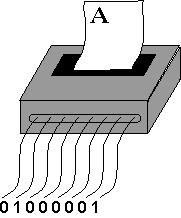Representing Characters
A groups of 8 bits is a byte. Typically one character is represented with one byte. The agreement by the American Standards Committee on what pattern represents what character is called ASCII. (There are several ways to pronounce "ASCII". Frequently it is pronounced "ásk-ee"). Most microcomputers and many mainframes follow this standard.

When a printer built to print ASCII receives the ASCII pattern for "A" (along with some control signals), it prints an "A". Printers built to other specifications (typically for mainframe computers) might print some completely different character if sent the same pattern.
Some ASCII patterns do not correspond to a printable character. For example, the pattern 0x00 (ie. 0000 0000) is the NUL character. NUL is often used as a marker in collections of data. The pattern 0x0A is the LF, linefeed character, sent to a printer to indicate that it should advance one line. The patterns 0x00 through 0x1F are called control characters and are used to control input and output devices. The exact use of a control character depends on the particular output device. Many control characters were originally used to control the mechanical functions of a teletype machine.
